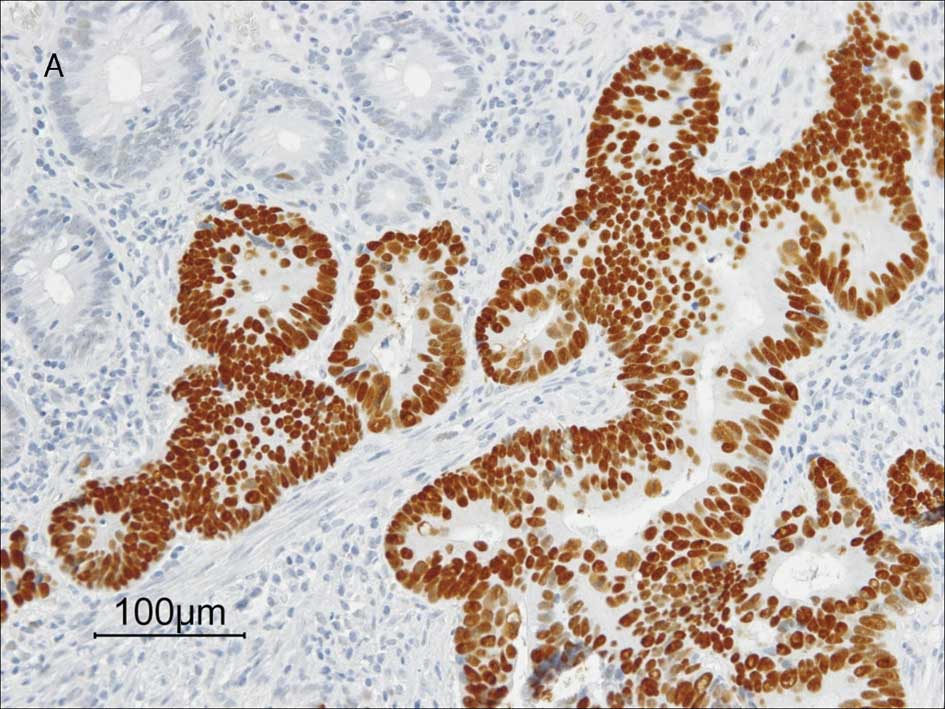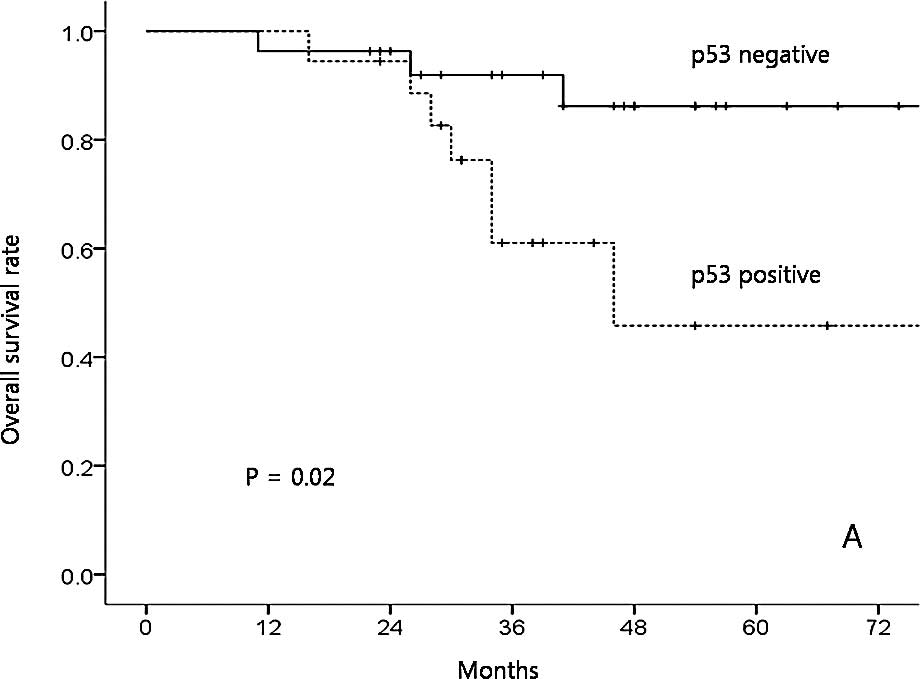|
1
|
Janjan NA, Khoo VS, Abbruzzese J, et al:
Tumor down-staging and sphincter preservation with preoperative
chemoradiation in locally advanced rectal cancer: the M.D. Anderson
Cancer Center experience. Int J Radiat Oncol Biol Phys.
44:1027–1038. 1999. View Article : Google Scholar
|
|
2
|
Kim JS, Cho MJ, Song KS and Yoon WH:
Preoperative chemoradiation using oral capecitabine in locally
advanced rectal cancer. Int J Radiat Oncol Biol Phys. 54:403–408.
2002. View Article : Google Scholar : PubMed/NCBI
|
|
3
|
Sauer R, Becker H, Hohenberger W, et al:
Preoperative versus postoperative chemoradiotherapy for rectal
cancer. N Engl J Med. 351:1731–1740. 2004. View Article : Google Scholar : PubMed/NCBI
|
|
4
|
Navarro M, Dotor E, Rivera F, et al: A
Phase II study of preoperative radiotherapy and concomitant weekly
irinotecan in combination with protracted venous infusion
5-fluorouracil, for resectable locally advanced rectal cancer. Int
J Radiat Oncol Biol Phys. 66:201–205. 2006. View Article : Google Scholar
|
|
5
|
Kim YH, Kim DY, Kim TH, et al: Usefulness
of magnetic resonance volumetric evaluation in predicting response
to preoperative concurrent chemoradiotherapy in patients with
resectable rectal cancer. Int J Radiat Oncol Biol Phys. 62:761–768.
2005.PubMed/NCBI
|
|
6
|
Chang HJ, Jung KH, Kim DY, et al: Bax, a
predictive marker for therapeutic response to preoperative
chemoradiotherapy in patients with rectal carcinoma. Hum Pathol.
36:364–371. 2005. View Article : Google Scholar : PubMed/NCBI
|
|
7
|
Giralt J, De las Heras M, Cerezo L, et al:
The expression of epidermal growth factor receptor results in a
worse prognosis for patients with rectal cancer treated with
preoperative radiotherapy: a multicenter, retrospective analysis.
Radiother Oncol. 74:101–108. 2005. View Article : Google Scholar
|
|
8
|
Kim JS, Kim JM, Li S, et al: Epidermal
growth factor receptor as a predictor of tumor downstaging in
locally advanced rectal cancer patients treated with preoperative
chemoradiotherapy. Int J Radiat Oncol Biol Phys. 66:195–200. 2006.
View Article : Google Scholar
|
|
9
|
Rau B, Sturm I, Lage H, et al: Dynamic
expression profile of p21WAF1/CIP1 and Ki-67 predicts survival in
rectal carcinoma treated with preoperative radiochemotherapy. J
Clin Oncol. 21:3391–3401. 2003. View Article : Google Scholar : PubMed/NCBI
|
|
10
|
Rodel F, Capalbo G, Rodel C and Weiss C:
Caveolin-1 as a prognostic marker for local control after
preoperative chemoradiation therapy in rectal cancer. Int J Radiat
Oncol Biol Phys. 73:846–852. 2009. View Article : Google Scholar : PubMed/NCBI
|
|
11
|
Levine AJ: p53, the cellular gatekeeper
for growth and division. Cell. 88:323–331. 1997. View Article : Google Scholar : PubMed/NCBI
|
|
12
|
Adell G, Sun XF, Stal O, Klintenberg C,
Sjodahl R and Nordenskjold B: p53 status: an indicator for the
effect of preoperative radiotherapy of rectal cancer. Radiother
Oncol. 51:169–174. 1999. View Article : Google Scholar : PubMed/NCBI
|
|
13
|
Rebischung C, Gerard JP, Gayet J, Thomas
G, Hamelin R and Laurent-Puig P: Prognostic value of p53 mutations
in rectal carcinoma. Int J Cancer. 100:131–135. 2002. View Article : Google Scholar : PubMed/NCBI
|
|
14
|
Weinberg RA: The retinoblastoma protein
and cell cycle control. Cell. 81:323–330. 1995. View Article : Google Scholar : PubMed/NCBI
|
|
15
|
Cui X, Shirai Y, Wakai T, Yokoyama N,
Hirano S and Hatakeyama K: Aberrant expression of pRb and
p16(INK4), alone or in combination, indicates poor outcome after
resection in patients with colorectal carcinoma. Hum Pathol.
35:1189–1195. 2004. View Article : Google Scholar : PubMed/NCBI
|
|
16
|
Ioachim E: Expression patterns of cyclins
D1, E and cyclin-dependent kinase inhibitors p21waf1/cip1, p27kip1
in colorectal carcinoma: correlation with other cell cycle
regulators (pRb, p53 and Ki-67 and PCNA) and clinicopathological
features. Int J Clin Pract. 62:1736–1743. 2008. View Article : Google Scholar
|
|
17
|
Fink D, Aebi S and Howell SB: The role of
DNA mismatch repair in drug resistance. Clin Cancer Res. 4:1–6.
1998.
|
|
18
|
Fishel R: The selection for mismatch
repair defects in hereditary nonpolyposis colorectal cancer:
revising the mutator hypothesis. Cancer Res. 61:7369–7374.
2001.PubMed/NCBI
|
|
19
|
Charara M, Edmonston TB, Burkholder S, et
al: Microsatellite status and cell cycle associated markers in
rectal cancer patients undergoing a combined regimen of 5-FU and
CPT-11 chemotherapy and radiotherapy. Anticancer Res. 24:3161–3167.
2004.
|
|
20
|
Bertolini F, Bengala C, Losi L, et al:
Prognostic and predictive value of baseline and posttreatment
molecular marker expression in locally advanced rectal cancer
treated with neoadjuvant chemoradiotherapy. Int J Radiat Oncol Biol
Phys. 68:1455–1461. 2007. View Article : Google Scholar
|
|
21
|
Momand J, Zambetti GP, Olson DC, George D
and Levine AJ: The MDM2 oncogene product forms a complex with the
p53 protein and inhibits p53-mediated transactivation. Cell.
69:1237–1245. 1992. View Article : Google Scholar : PubMed/NCBI
|
|
22
|
Kondo I, Iida S, Takagi Y and Sugihara K:
MDM2 mRNA expression in the p53 pathway may predict the potential
of invasion and liver metastasis in colorectal cancer. Dis Colon
Rectum. 51:1395–1402. 2008. View Article : Google Scholar : PubMed/NCBI
|
|
23
|
Forslund A, Zeng Z, Qin LX, et al: MDM2
gene amplification is correlated to tumor progression but not to
the presence of SNP309 or TP53 mutational status in primary
colorectal cancers. Mol Cancer Res. 6:205–211. 2008. View Article : Google Scholar : PubMed/NCBI
|
|
24
|
Kudrimoti M, Lee EY, Kang Y, Ahmed M and
Mohiuddin M: Genetic markers predictive of response to induction
chemoradiotherapy for locally advanced rectal cancers. J Ky Med
Assoc. 105:18–22. 2007.PubMed/NCBI
|
|
25
|
Tzouvala M, Lazaris AC, Papatheodoridis
GV, et al: Potential role of apoptosis and apoptotic regulatory
proteins in colorectal neoplasia: correlations with
clinico-pathological parameters and survival. Dig Dis Sci.
53:451–460. 2008. View Article : Google Scholar : PubMed/NCBI
|
|
26
|
Xia F, Wang X, Wang YH, Tsang NM, Yandell
DW, Kelsey KT and Liber HL: Altered p53 status correlates with
differences in sensitivity to radiation-induced mutation and
apoptosis in two closely related human lymphoblast lines. Cancer
Res. 55:12–15. 1995.PubMed/NCBI
|
|
27
|
Shimoji H, Miyazato H, Nakachi A, et al:
Expression of p53, bcl-2 and bax as predictors of response to
radiotherapy in esophageal cancer. Dis Esophagus. 13:185–190. 2000.
View Article : Google Scholar : PubMed/NCBI
|
|
28
|
Lin LC, Lee HH, Hwang WS, et al: p53 and
p27 as predictors of clinical outcome for rectal-cancer patients
receiving neoadjuvant therapy. Surg Oncol. 15:211–216. 2006.
View Article : Google Scholar : PubMed/NCBI
|
|
29
|
Terzi C, Canda AE, Sagol O, et al:
Survivin, p53 and Ki-67 as predictors of histopathologic response
in locally advanced rectal cancer treated with preoperative
chemoradiotherapy. Int J Colorectal Dis. 23:37–45. 2008. View Article : Google Scholar : PubMed/NCBI
|
|
30
|
Gosens MJ, Dresen RC, Rutten HJ, et al:
Preoperative radiochemotherapy is successful also in patients with
locally advanced rectal cancer who have intrinsically high
apoptotic tumours. Ann Oncol. 19:2026–2032. 2008. View Article : Google Scholar : PubMed/NCBI
|
|
31
|
Guy M, Moorghen M, Bond JA, Collard TJ,
Paraskeva C and Williams AC: Transcriptional down-regulation of the
retinoblastoma protein is associated with differentiation and
apoptosis in human colorectal epithelial cells. Br J Cancer.
84:520–528. 2001. View Article : Google Scholar : PubMed/NCBI
|
|
32
|
Ikeguchi M, Ueda T, Fukuda K, Yamaguchi K,
Tsujitani S and Kaibara N: Expression of the murine double-minute
gene 2 oncoprotein in esophageal squamous cell carcinoma as a novel
marker for lack of response to chemoradiotreatment. Am J Clin
Oncol. 25:454–459. 2002. View Article : Google Scholar : PubMed/NCBI
|
|
33
|
Garcia del Muro X, Condom E, Vigues F, et
al: p53 and p21 expression levels predict organ preservation and
survival in invasive bladder carcinoma treated with a
combined-modality approach. Cancer. 100:1859–1867. 2004.PubMed/NCBI
|
|
34
|
McKay JA, Douglas JJ, Ross VG, et al:
Analysis of key cell-cycle checkpoint proteins in colorectal
tumours. J Pathol. 196:386–393. 2002. View Article : Google Scholar : PubMed/NCBI
|
|
35
|
Gong JG, Costanzo A, Yang HQ, Melino G,
Kaelin WG Jr, Levrero M and Wang JY: The tyrosine kinase c-Abl
regulates p73 in apoptotic response to cisplatin-induced DNA
damage. Nature. 399:806–809. 1999. View
Article : Google Scholar : PubMed/NCBI
|
|
36
|
Davis TW, Wilson-Van Patten C, Meyers M,
et al: Defective expression of the DNA mismatch repair protein,
MLH1, alters G2-M cell cycle checkpoint arrest following ionizing
radiation. Cancer Res. 58:767–778. 1998.PubMed/NCBI
|
|
37
|
Nam TK, Lee JH, Cho SH, et al: Low hMLH1
expression prior to definitive chemoradiotherapy predicts poor
prognosis in esophageal squamous cell carcinoma. Cancer Lett.
260:109–117. 2008. View Article : Google Scholar : PubMed/NCBI
|
|
38
|
Geyer RK, Yu ZK and Maki CG: The MDM2
RING-finger domain is required to promote p53 nuclear export. Nat
Cell Biol. 2:569–573. 2000. View
Article : Google Scholar : PubMed/NCBI
|
|
39
|
Xiao ZX, Chen J, Levine AJ, Modjtahedi N,
Xing J, Sellers WR and Livingston DM: Interaction between the
retinoblastoma protein and the oncoprotein MDM2. Nature.
375:694–698. 1995. View
Article : Google Scholar : PubMed/NCBI
|
















